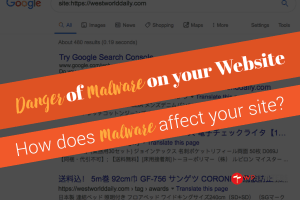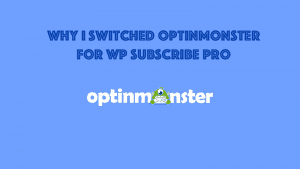FluentCart loads 111,000 orders instantly on a $30 server. That’s not a typo. For anyone who has managed a WordPress ecommerce store, that sentence alone is enough to signal that something fundamentally different is happening here.
As a web developer, digital agency owner, and someone who has used WordPress since 2008, I have seen, purchased and tested numerous plugins that promise to revolutionize ecommerce. Yet, most stores still grapple with performance bottlenecks, a patchwork of expensive addons, and the constant fear that a single update will break everything.
This review is my first-look analysis of FluentCart, a WPManageNinja product, putting it through its paces to see if it truly solves the problems it claims to after testing it for a week alongside live SureCart and WooCommerce stores.
At a Glance: Speed, Value, and a Modern Architecture
FluentCart’s greatest strengths are its speed and its affordable extensibility. The WPManageNinja team built this after becoming frustrated with the limitations of Easy Digital Downloads. It reminds me of the quote by Shopify founder Tobi Lutke: “It is incredibly powerful if you solve the problem you actually have yourself.”
The secret to its speed lies in a wise architectural choice: FluentCart utilizes its own dedicated database tables for orders, customers, and product attributes, including variations, among others. This means the indexing of thousands of products within a second or less, resulting in high performance as the software can quickly go to the indexed product.
These dedicated database tables are a significant advantage, as they prevent the bloat that slows down WooCommerce, which must sift through the inefficient wp_postmeta tables. WooCommerce now has to play catch-up, as it’s not easy to move its extensive third-party plugin ecosystem to a more efficient database table.
FluentCart comes bundled with a full subscription engine, making it ideal for digital product owners. This single feature provides incredible value, as the official WooCommerce Subscriptions extension costs a hefty $279 per year.
This is a stark contrast to Shopify, which lacks a robust subscription engine and forces merchants into costly third-party apps like Recharge, where plans can quickly jump to $99/month plus additional transaction fees.
First Impressions: A Walkthrough
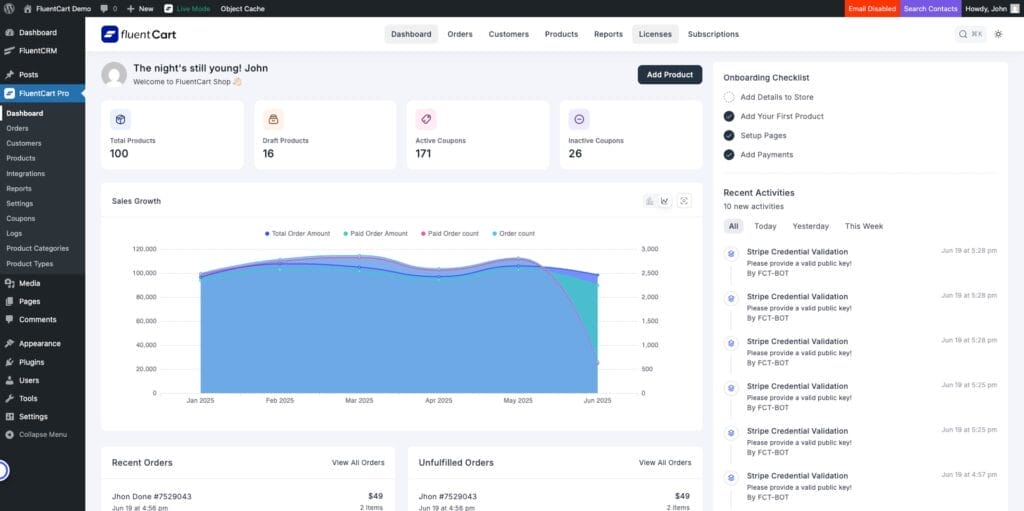
FluentCart is fast and well-designed, offering a good user experience with details in the right places. I started by visiting the dashboard and saw a bird’s-eye view of what was happening with the demo store. It’s a busy dashboard, and rightly so, as online store owners want a dashboard that helps them quickly understand their sales.
Fast Admin Pages for Orders & Customers
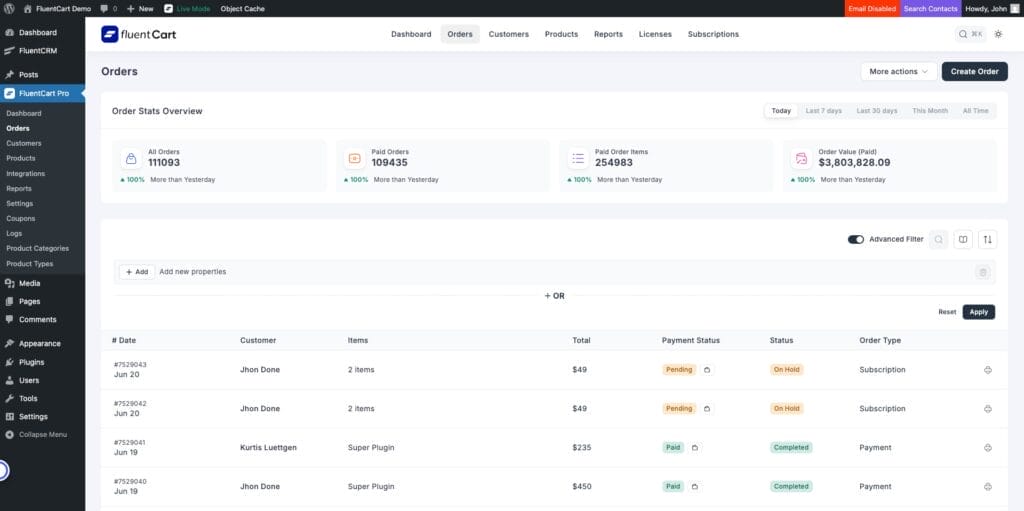
I clicked through the various pages and found them loading very quickly. Even the Orders Page loads instantly, despite the demo site running on a $30 server with over 111,000 orders.
The Customers page is just as fast and displays the purchase count, which is great for spotting top customers. It would be beneficial if we could view the “total spend” by a customer, similar to WooCommerce, as that helps us understand their lifetime value.
Detailed Reporting with Room to Grow
The Reports Page is detailed and well-organized, with subpages for Overview, Sales, Orders, Revenue, Refunds, and Subscriptions. Revenue is good as it lets me know how much I’m making after subtracting discounts and refunds from gross sales.
I like the ‘Orders’ subsection under Reports, as we can see the AOV (Average Order Value) upfront. What would make it even better is the ability to view stuff like Order Frequency or Items Most Commonly Bought Together. I also hope we can key in the cost per item and view the profits as well.
Game-Changing Built-in Subscriptions
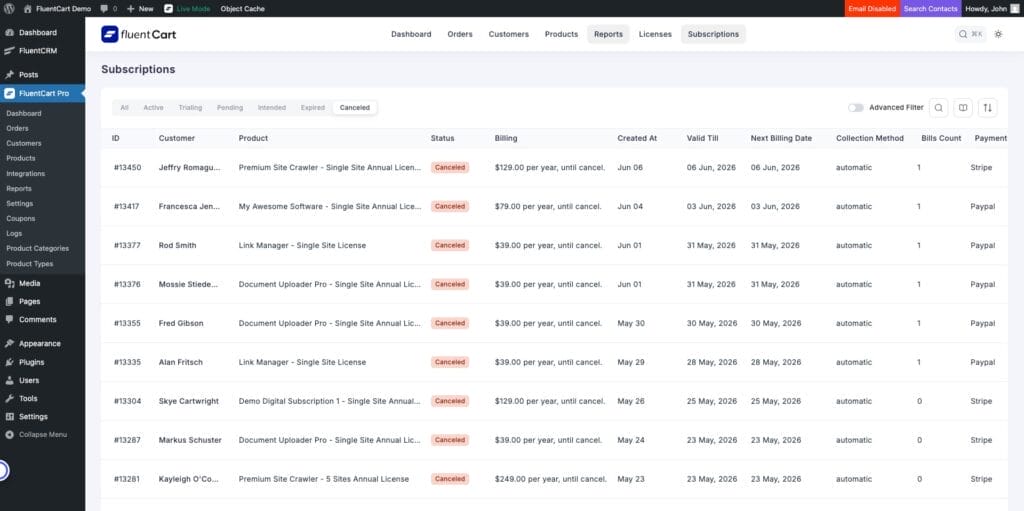
FluentCart’s most disruptive feature is its built-in subscription and license management engine, which directly challenges the expensive addon model of competitors and makes it a fantastic choice for anyone selling software or memberships.
While it’s a strong start, it’s not yet fully mature. Community feedback has confirmed that the ability to add or edit a subscription manually from the backend is not yet available, which is a critical administrative function.
Developer Features & Ecosystem Strategy
The Fluent Ecosystem with A Promising Third-Party Ecosystem Potential
It’s important to view FluentCart as a cornerstone of the “Fluent Ecosystem.” The team is building a unified platform where all their tools work together seamlessly. This is a huge plus if you’re already using their other plugins like FluentCRM.
Some have wondered if this creates an “Apple syndrome” where plugins only work well with their siblings. However, given that other Fluent plugins have numerous third-party integrations, it’s more likely that FluentCart’s launch will focus on its own ecosystem first, with broader integrations to follow.
To answer my questions, I conducted research and found that FluentCart is developer-friendly, featuring a comprehensive REST API and webhooks, which makes it easy for developers to extend and connect to the platform.
What does this mean to you? FluentCart will be as extensible as WooCommerce, ensuring an ecosystem of third-party plugins will be built around it, making FluentCart more valuable over time.
Pricing Transparency: FluentCart vs. Shopify
A significant pain point for many store owners is the escalating cost of essential apps on platforms like Shopify. A direct cost comparison reveals FluentCart’s compelling value proposition, and while its final pricing isn’t public, it’s projected to be highly competitive.
| Cost Component | FluentCart (Projected) | Typical Shopify Store |
| Platform Fee | ~$99 / year | $348 – $468 / year ($29-$39/mo) |
| Essential Apps | Included (Subscriptions, Advanced Analytics) | $600 – $1,800 / year ($50-$150/mo) |
| Transaction Fees | Depends on Gateway (e.g., Stripe, PayPal) | Up to 2.9% + 30¢ (Shopify Payments) or an additional 0.6% – 2% fee if using a third-party gateway. |
| Total Estimated Annual Cost | ~$99 + Gateway Fees | ~$948 – $2,268 + Transaction Fees |
Security & Support
When it comes to security, FluentCart handles this by integrating with trusted, PCI-compliant payment gateways like Stripe and PayPal. By using modern methods like tokenization, sensitive card data is sent directly to Stripe, bypassing your server entirely. This makes your PCI compliance burden much lower.
As for support, WPManageNinja officially reports a 95% customer satisfaction rate. However, looking at real-world user reviews, a recurring complaint is that support response times can be slow, sometimes taking several days. This is something to keep in mind.
Early Verdict and Lingering Questions
I like what I see with FluentCart. The lightning-fast speed, thanks to its smart architecture, makes it a joy to work with. I foresee significant relief for clients when we finally migrate them to FluentCart. Instead of having to wait for the Orders or Customers page to load, they can focus on growing their business online.
Who is it for?
- Ideal Adopters Today:
- SaaS companies and software developers selling license-based products.
- Course creators and membership sites built on recurring revenue.
- Any business that has hit the performance wall with WooCommerce and primarily sells digital goods.
- Agencies and users already committed to the Fluent product ecosystem.
- Who Should Wait?
- Stores selling physical goods with complex, rule-based shipping needs, at least until the planned ‘Advanced Shipping’ module is released and fully mature
- Businesses that are critically dependent on a specific WooCommerce extension for which no FluentCart equivalent exists, until a native or third-party FluentCart equivalent is built.
- Users who prioritize access to the largest possible pool of third-party add-ons over the benefits of a unified ecosystem.
FluentCart isn’t a “WooCommerce killer” across the board—not yet. But for a significant and growing segment of the market, it’s already a superior choice.




